Authors
Yu Bin

YU Bin (于滨, Ph.D Stanford) is professor of political science and director of East Asian Studies at Wittenberg University (Ohio, USA). Yu is also a senior fellow of the Shanghai Association of American Studies, senior fellow of the Russian Studies Center of the East China Normal University in Shanghai, and senior advisor to the Intellisia Institute in Guangzhou, China. Yu is the author and co-author of six books and more than 150 book chapters and articles in journals including World Politics, Strategic Review, China and Eurasia Forum Quarterly, Asia Policy, Asian Survey, International Journal of Korean Studies, Journal of Chinese Political Science, Harvard International Review, Asian Thought and Society. Yu has also published numerous opinion pieces in many leading media outlets around the world such as International Herald Tribune (Paris), Asia Times, People’s Daily (Beijing), Global Times (Beijing), China Daily, Foreign Policy In Focus (online), Yale Global (online), Valdai Club, the BBC, Public Radio (USA), Radio Beijing, Radio Australia. Previously, he was a fellow at the Strategic Studies Institute (SSI) of the US Army War College, East-West Center in Honolulu, president of Chinese Scholars of Political Science and International Studies, a MacArthur fellow at the Center of International Security and Arms Control at Stanford and a research fellow at the Center of International Studies of the State Council in Beijing.
Articles by Yu Bin

China - Russia
January — April 2024“March Madness” in Moscow and Beyond…
The concert hall massacre near Moscow on March 22 was a source of shock and awe for Russia and the world. The incident, which resulted in the deaths of 144 people and 551 wounded, was the largest since the 2003 Beslan school siege (where more than 330 hostages died). Its timing cast a long shadow over major developments in the first few months of 2024, particularly the fifth term of President Vladimir Putin, who won 87.28% of the vote just five days prior. It also made any effort to end the two-year Ukraine war more difficult, if not impossible. As a result, much of China’s mediation 2.0 (March 2-12) was in parking mode. The Sino-Russian strategic partnership, too, was tested by two different priorities: Moscow’s need for more security coordination on one hand and China’s interest in stability in the bilateral, regional, and global domains on the other. Whatever the outcome, the stage was set for more dynamic interactions between the two large powers in the months ahead.
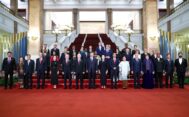
China - Russia
September — December 2023From Geopolitics to Geoeconomics
In the last months of 2023, China and Russia increasingly prioritized economics and geoeconomics in their bilateral interactions. In the post-COVID era and with a virtual standstill in the Russian-Ukraine war, both sides searched for new growth potential in domestic, bilateral, and multilateral domains. In October, Russian President Putin visited Beijing for the 3rd Belt and Road Forum (BRF), which was attended by thousands of participants from 151 countries. It was a convenient occasion for Putin to expand his diplomacy, which had been considerably strained by Western sanctions since early 2022. Putin’s lengthy meetings (formal talks, a working lunch, and a “private tea meeting”) took almost half a day for the two-day BEF. Ten years after Xi’s launch of the Belt and Road Initiative (BRI), both sides found it necessary to adjust their policies between the increasingly globalized BRI and Russia’s regional grouping, the Eurasian Economic Union (EAEU).
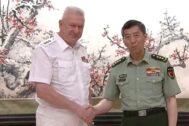
China - Russia
May — August 2023Testing the Limits of Strategic Partnership
In the summer months, both the upper and lower limits of the China-Russia strategic partnership were put to considerable tests. In the West, China’s peace-probing effort continued despite virtual stalemate in the Ukraine war and its sudden twists and turns (drone attacks on the Kremlin and Wagner mutiny). Beijing treaded carefully in restoring relations with Kyiv with the new Ukrainian ambassador in place. In the East, Russian and Chinese militaries conducted a series of aerial and naval exercises/operations with unprecedented scope and closer interoperability for almost three months (from early June to late August), something not seen even at the peak of the Sino-Soviet alliance in the 1950s. All of this occurred against the backdrop of increasingly hardened US-led alliance networks both in Indo-Pacific and beyond.

China - Russia
January — April 2023War and Peace for Moscow and Beijing
Perhaps more than any other time in their respective histories, the trajectories of China and Russia were separated by choices in national strategy. A year into Russia’s “special military operation” in Ukraine, the war bogged down into a stalemate. Meanwhile, China embarked upon a major peace offensive aimed at Europe and beyond. It was precisely during these abnormal times that the two strategic partners deepened and broadened relations as top Chinese leaders traveled to Moscow in the first few months of the year (China’s top diplomat Wang Yi, President Xi Jinping, and newly appointed Defense Minister Li Shangfu). Meanwhile, Beijing’s peace initiative became both promising and perilous as it reached out to warring sides and elsewhere (Europe and the Middle East). It remains to be seen how this new round of “Western civil war” (Samuel Huntington’s depiction of the 1648-1991 period in his provocative “The Clash of Civilizations?” treatise) could be lessened by a non-Western power, particularly after drone attacks on the Kremlin in early May.
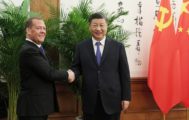
China - Russia
September — December 2022Ending the War? Or the World?
As the Ukraine conflict was poised to expand, the “extremely complicated” situation at the frontline (in Vladimir Putin’s words on Dec. 20) gave rise to intensified high-level exchanges between Moscow and Beijing as they searched for both an alternative to the conflict, and stable and growing bilateral ties. As the Ukraine war dragged on and mustered a nuclear shadow, it remained to be seen how the world would avoid what Henry Kissinger defined as a “1916 moment,” or a missed peace with dire consequences for not only the warring parties but all of civilization.
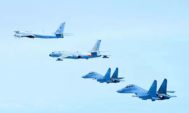
China - Russia
May — August 2022Embracing a Longer and/or Wider Conflict?
Unlike in 1914, the “guns of the August” in 2022 played out at the two ends of the Eurasian continent. In Europe, the war was grinding largely to a stagnant line of active skirmishes in eastern and southern Ukraine. In the east, rising tension in US-China relations regarding Taiwan led to an unprecedented demonstrative use of force around Taiwan. Alongside Moscow’s quick and strong support of China, Beijing carefully calibrated its strategic partnership with Russia with signals of symbolism and substance. Xi and Putin directly conversed only once (June 15). Bilateral trade and mil-mil ties, however, bounced back quickly thanks to, at least partially, the “Ukraine factor” and their respective delinking from the West. At the end of August, Mikhail Gorbachev’s death meant so much and yet so little for a world moving rapidly toward a “war with both Russia and China,” in the words of Henry Kissinger.

ROUNDTABLE
June 13, 2022Flashpoints in the Indo-Pacific Following the Russian invasion of Ukraine
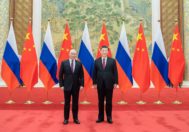
China - Russia
January — April 2022Ukraine Conflict Déjà Vu and China’s Principled Neutrality
Perhaps more than any month in history, February 2022 will come to symbolize how the states of peace and war can flip-flop in a few days, with dire consequences for the global order. On Feb. 21, just one day after the closing ceremony of the Beijing Winter Olympics, Russia announced its official recognition of the independence of the two breakaway regions (Donetsk and Luhansk) of Ukraine. Three days later, Russia launched its “special military operation” in Ukraine to end the “total dominance” and “reckless expansion” of the United States on the world stage (in the words of Russian Foreign Minister Sergei Lavrov). As the West imposed sanctions on Russia and rushed arms into Ukraine, China carefully navigated between the warring parties with its independent posture of impartiality.
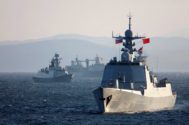
China - Russia
September — December 2021Not So Quiet in the Western Pacific
For Moscow and Beijing, relations with Washington steadily deteriorated toward the yearend. This was in sharp contrast from early 2021 when both had some limited expectations for relaxed tensions with the newly inaugurated Biden administration. For Russian President Vladimir Putin and his Chinese counterpart Xi Jinping, each of their meetings (real and virtual) with Biden was frontloaded with obstacles: US sanctions, a boycott of the 2022 Winter Olympics, and screw-tightening at strategic places (Taiwan and Ukraine). Biden’s diplomacy-is-back approach—meaning US-led alliance-building (the Quadrilateral Security Dialogue and AUKUS for China) or reinvigorating (NATO for Russia)—turned out to be far more challenging than Trump’s erratic go-it-alone style. It was against this backdrop that China and Russia enhanced their strategic interactions in the last few months of 2021, particularly mil-mil relations at a time of rising tensions in the western Pacific.
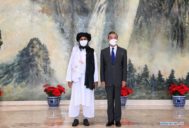
China - Russia
May — August 2021Afghan Endgame and Guns of August
The summer of 2021 may be the best and worst time for Russia-China relations. There was much to celebrate as the two powers moved into the third decade of stable and friendly relations, symbolized by the 20th anniversary of both the Shanghai Cooperation Organization (SCO) and the “friendship treaty” (The Treaty of Good-Neighborliness and Friendly Cooperation Between the People’s Republic of China and the Russian Federation). This historical moment, however, paralleled a hasty and chaotic end to the 20-year US interlude in Afghanistan with at least two unpleasant consequences for Beijing and Moscow: a war-torn Afghanistan in their backyard with an uncertain future and worse, a United States now ready to exclusively focus on the two large Eurasian powers 30 years after the end of the Cold War. As the Afghan endgame rapidly unfolded in August, both sides were conducting large exercises across and around Eurasia. While Afghanistan may not again serve as the “graveyard of empires” in the 21st century, the end of the US engagement there will usher in an era of competition, if not clashes, between rival empires.